





Living with the wind can be a challenge if one is also trying to grow a garden. And if your climate already is challenging, the additive effect is daunting. More on the frustrations of being a misplaced gardener.
When I moved to Acton, California from the fertile valley of Los Angeles down the hill some 40 miles, I was fearing the worst for my plants. Would they survive the cold.. because it gets a lot colder here than in Tarzana? Would they survive the heat (gets not only hot here in the high desert (over 100 most of the summer) but also it is dry dry dry)? And what of these dusty, lifeless desert soils? I had many concerns, but wind was not one of them, as I was used to living through Santa Anas in the valley (and in most of southern California- a seasonal event)... these are warm, brutal desert winds that can howl though all of Los Angeles, knocking over trees and down power lines. But I was not prepared, nor had I even considered what would happen should EVERY DAY be windy, and some windy like a hurricane is windy.
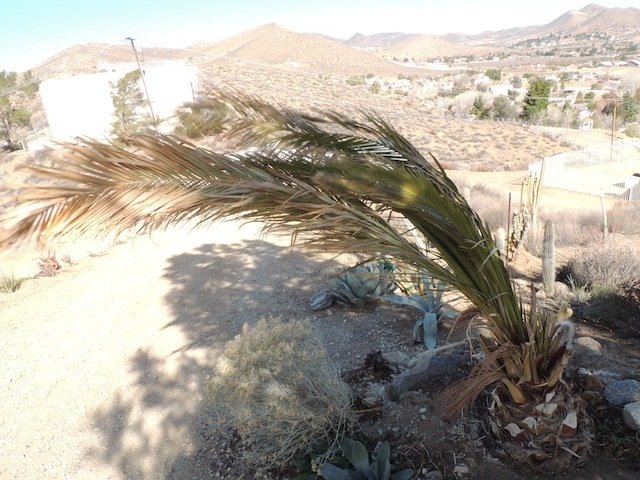
Phoenix canariensis blowing in the wind from the north (winter time) about 50mph
When we first moved to Acton, it was on a particularly windy day... or so we thought. The property was rimmed with many nice Italian Cypress and they were all bowing under the force of the winds, which were, as expected, coming in from the desert. The wind blew all day and when it continued on the second day, only from the very opposite direction, I began to wonder when the windy season was in this area, as this was not normally the windy season in the valley below. When asking about town, one vendor pointed out a T-shirt with a large title on it: Acton Wind Festival. So, it is exceptionally windy here... wonder when the festival is- hopefully it is this time of year. But then I see on the T-shirt's back the festival's dates: January 1- December 31. Uh oh... I began to suspect the T-shirt's advertisement was a joke and there really was no such festival (duh!). It was then I began to worry there were going to be a lot of windy days in Acton. Oh well, I had lived in windy places before (or so I thought).
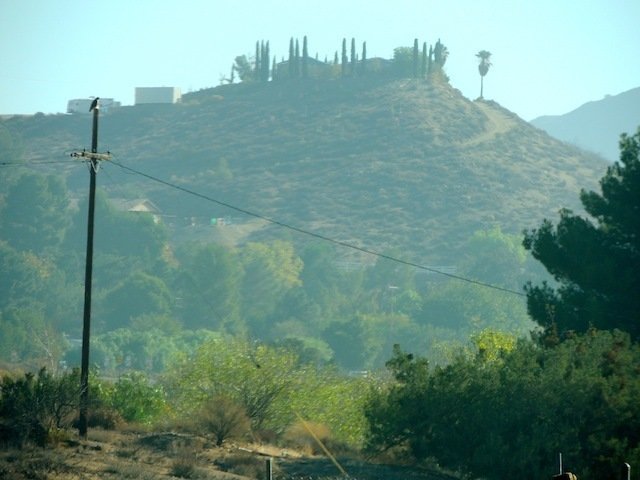
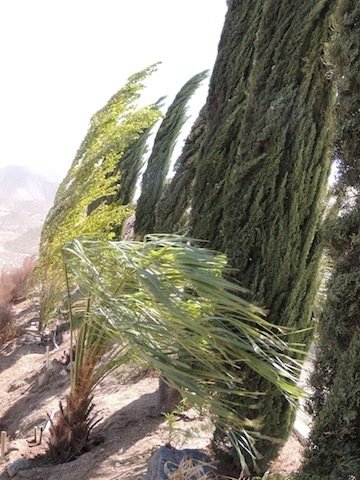
View of property from below- so not only do we live in a windy town, but possibly THE windiest place in town (left); right shows a view of what 50 mph winds look like (hard to stand up)
At first the wind was sort of pleasant... kept it from getting super hot up here on our little hill in Acton which is considered part of the high desert. Even though the actual desert is a giant flat, featureless plain we can only see in the distance, it does get quite toasty here on our little hill (40-60 days a year over 100F). turns out wind is definitely a desert feature. Wind is also a hilltop feature, and our home is on the very top of a hill in Acton, which itself is on a giant hill, or rather a low mountain ridge separating the inland desert (Mojave) from the coastal regions of Los Angeles. And this ridge is actually a natural pass which is why the highway goes through Acton. And natural passes often let through more than just traffic ... they often are main passageways for stuff like weather. Eventually we began to realize that it was going to be windy a lot of the time, possibly much of the year. Some days were better than others with winds of only 15-20 mph, and others with winds up to 60mph (would lose roof tiles and blow over large potted plants on those days). Winds were so high that we could hardly stand on the edge of the property top with being knocked off balance (bad when walking through our new cactus garden!).
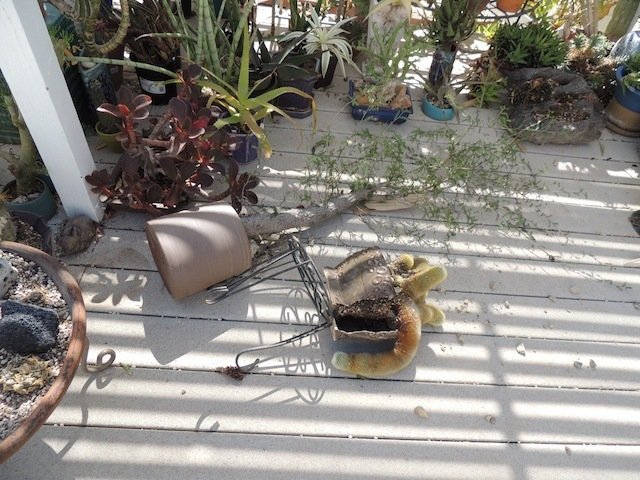
stopped putting pots on stands... they just keep blowing off, even if full of heavy plants
We begn to note that not only was it windy every single day, but the wind direction changed frequently, sometimes blowing from up to 3 different directions in the same day, often all with 'gale force'. This made putting things out of the wind nearly impossible because it was everywhere. There was really no 'leeward' side to our house, being exposed as it is atop a hill with slopes 360 degrees. And as time went on, we realized there was no windy season, either. Wind was a fact of daily life here, particularly on our hill. So far, out of the nearly 2 years we have been here, we have had 2 nearly windless days (nearly). The rest have been windy with winds averaging about 20-25 mph, and all day long (often only a bit breezy in the early AMs until 8-9AM), and often relatively calm once dark. Too bad it's not dark all the time... but then the plants really wouldn't grow at all, would they?
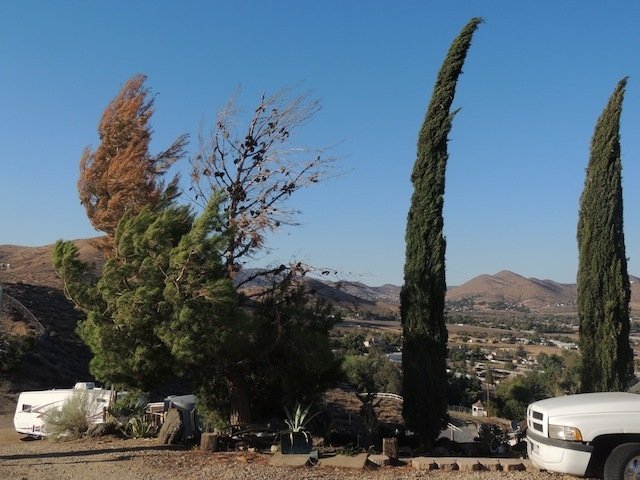
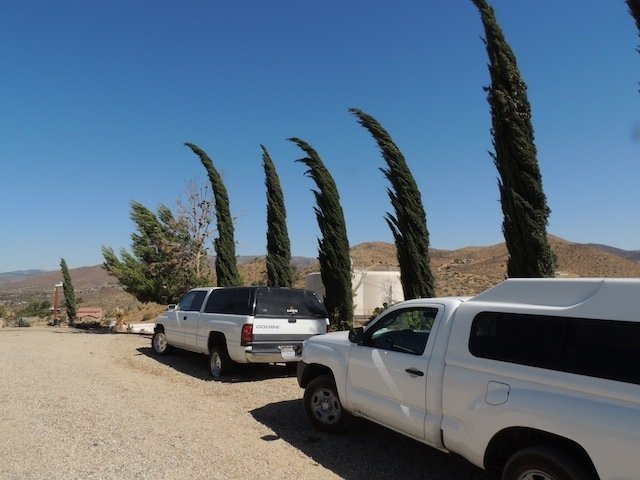
summer winds blowing Italian Cypress. Note dying pine's dead branches have a permanent wind-blown look to them ; then in second picture the winds tend to blow the opposite direcrtion in winter
Summer time has the winds blowing mostly from the south, though southeast and southwest is a nearly daily variation. These winds are hot, though primarily from the coast, so they certainly could be hotter (thank goodness for something!). We have many days in the 100s, but when the winds blow in the afternoon (usually25-30 mph) it does cool things down to a comfortable 90-95F. In fall, there are the dreaded Santa Ana winds, which are furnace winds, only from the opposite direction (north or northeast). These always catch us off guard, giving the plants that were protected on the north side of the house a good lesson in humility. Then comes winter- these winds are from north as well, but more the northwest... and they are really really cold. This makes things trying to grow on the north side of the property (those that survived the Santa Anas) really crispy unless very well established and able to grow at a close angle to the ground.
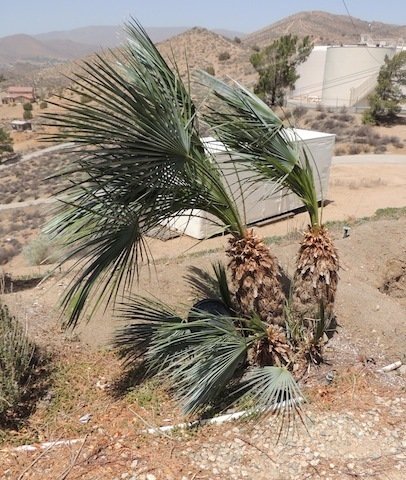
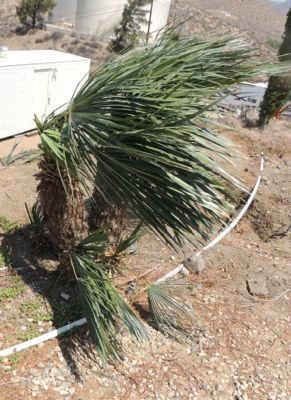
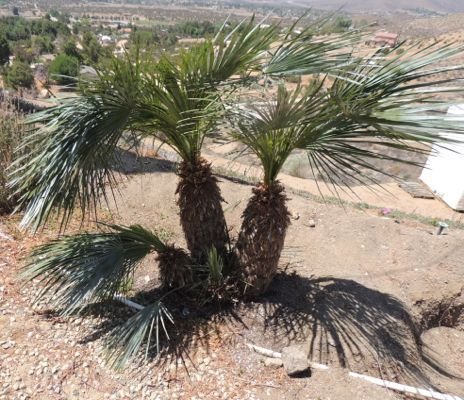
Chamaerops, one of my favorite palms brought from Los Angeles, showing change in wind direction, all during the same day (from the north, then the south, then the west)
Wind can have a positive effect on some plants, in moderation of course (something we simply don't have here). Wind strengthens the stems of and trunks of plants by stimulating them to thicken their supporting structures. This makes them somewhat less prone to blow over, at least break off in parts. Some would-be pests are also blown away by strong gusts... sadly we have a pretty hardy bunch of pests up here in Acton and all the wind int the world does not seem to dissuade them much. After particularly bad winds some plants have lost all their leaves, yet the bugs are still on the naked stems wondering where their meals went. Wind also moves the air around improving a plants exposure to available carbon dioxide. It also helps to disperse their seeds. But really, these are small bonuses compared to all the bad things wind does.
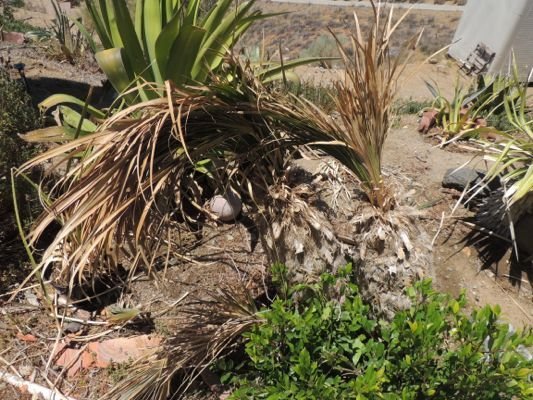
same palm as above about 10 months later showing what wind does over time to poorly adapting plants... nearly dead now (and this is one of the toughest palms on the planet!)
Aside from being annoying, though, wind has other ramifications. I should not have worried about my plants I moved up from Tarzana... turns out worrying never helps! Almost all the plants suffered severely or died no matter how much I worried. And the wind turned out to be the primary cause of their demise. ...As it has been the demise, since, of most new and supposedly acclimated plants I have acquired from local sources, as well. Wind is part of daily life in the Anteleope Valley and many of the plants grown here can adapt to it... but the wind one encounters atop a hill in a mountain pass town is an whole 'nuther thing. Growing plants on our property is like growing them in the back of a pickup truck driving down the freeway at top speed... all day long, every day, hot or cold, rainy or sunny. This constant high wind exposure has a profound effect upon many plants. The main one is that it simply makes the atmosphere incompatible with plant life.
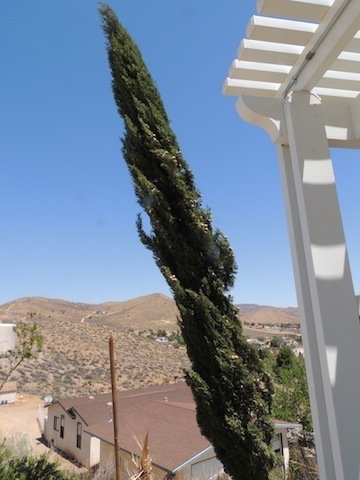
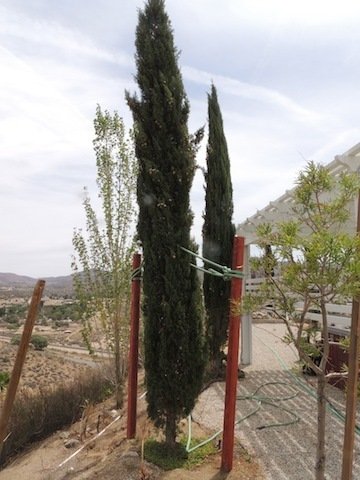
This Italian Cypress was planted years ago and is an established tree with a relatively large root system... yet on a day we had a 'tad' over 50 mph winds, it blew half way over. Staked it up with wooden posts concreted into the ground.
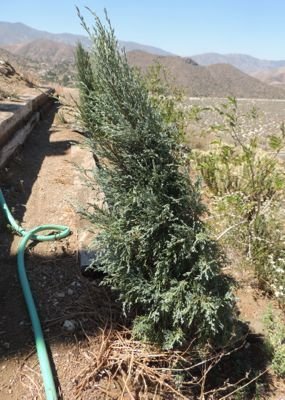
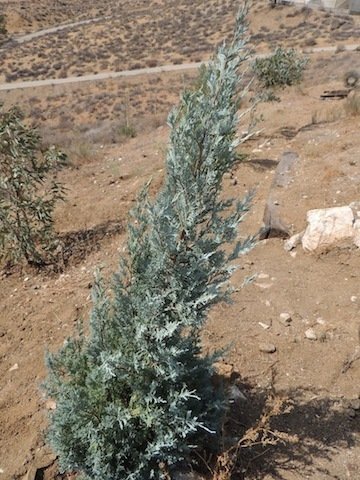
two different conifers planted showing effects of growing in wind... both now have 'permanent' leans to them (depending upon time of year planted)... definitely should have staked these ones (oops). They are only a few feet tall... did not think they needed staking, too.
Wind does physical damage to plants. That seems rather obvious of course and no one should be surprised by that. We have had trees blown over, branches, leaves, flowers and fruit blown off them, and all sorts of things blown onto or into them (such as our neighbor's trash). Our nectarine tree started out this season with about 20 fruits on it... one unusually blustery day and we are down to 2... the rest blown off in various directions. The apple trees bloomed well this season, but thanks to the wind, most flowers blew off and between two trees, we have a single apple growing. Any ornamental broad leaf tree that has been brought up here had most, if not all its leaves blown off by fall, making the process of going deciduous rather premature. Some of my new trees now only sport leaves about a foot or so about ground level.
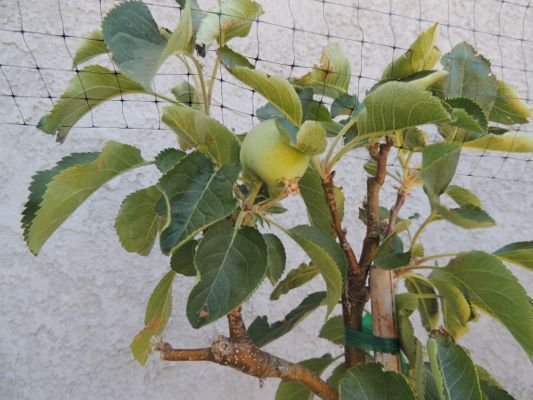
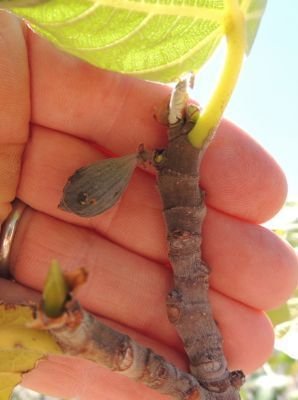
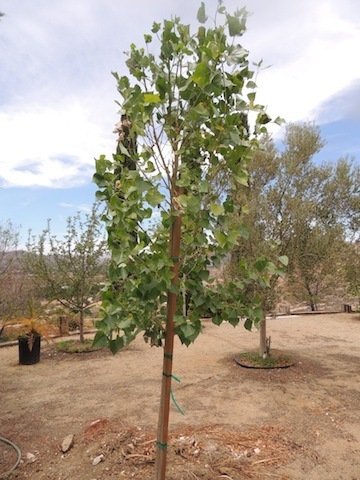
Not had much luck with fruit... this apple tree had several dozen apples on it at the nursery... bloomed great and had dozens of flowers... all but one which blew off... so we got ONE apple this season (left); center shows typical wind damage to figs (tree gets LOTS of water and produces a LOT of figs...)- but all dry up and fall off after particuarly hot, dry winds. So far, not a single fig has made it maturity. All the nectarines were blown off during a particularly swirly wind event (right)
In addition, the constant wind has desiccating effects that I am just now beginning to grasp their magnitude. Leaves not only tend to get blown off, but they begin to curl and become deformed. Some trees now have only miniature leaves, shrunken representatives of their former selves. Many flowers last only moments before they cave in on themselves from the loss of moisture. I have many cacti growing along one edge of the top of the yard and they are among the few plants that actually seem to like this climate. However, despite their blooming frequently, flowers last maybe a few hours before they shrivel in the wind, or literally get blown off.

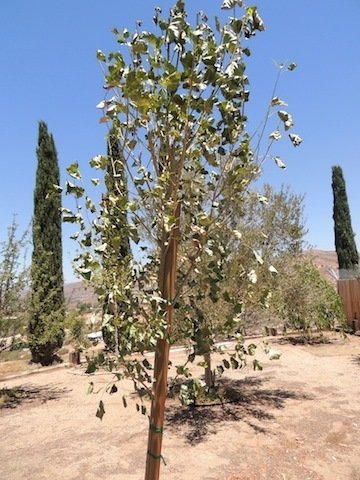
This took us a bit by surprise... lots of established cottonwood trees in the lower elevations... planted this nice tree out... a few days later it blew hard and despite watering the tree well, it completely dessicated nearly overnight. Dead. Bummer.
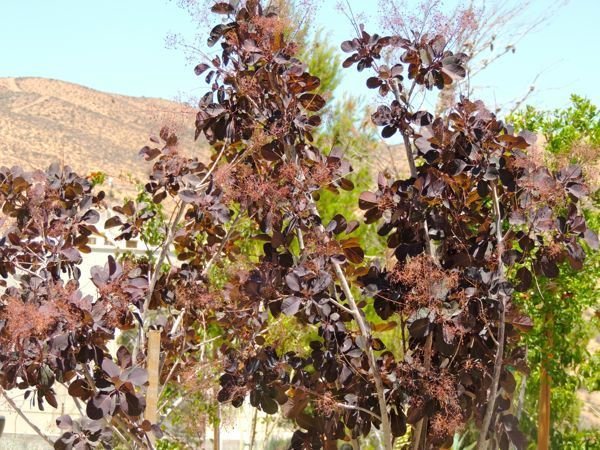
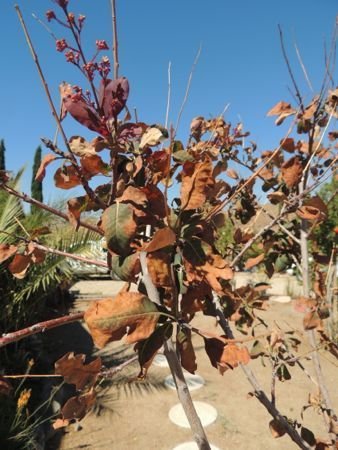
Cotinus (Smoke Tree) in spring after new leaves formed... and in fall after a summer of hot wind (despite watering under various schemes)
Desiccating winds have an additional negative effect upon plants. Most plants have the ability to alter their transpiration (loss of water through their foliage) by closing their stomas (microscopic 'pores' in the leaf surface). This life-saving action keeps the plants from dying on the spot from completely desiccating all their leaves... but this closed stoma situation also means there can be no active photosynthesis (I say active since some xeric plants have a way around this). The end result are plants that don't grow much and tend to be stunted. I cannot think of how many nice trees I have purchased, planted and now they are dwarfs of their former selves, with not only living leaves just a few feet about the ground but all their new growth is stunted and the branches hardly grow at all. Some find dwarf trees ornamental, but I was hoping to create some useful canopy up here, at least canopy high enough to plant under or even some day, walk under.
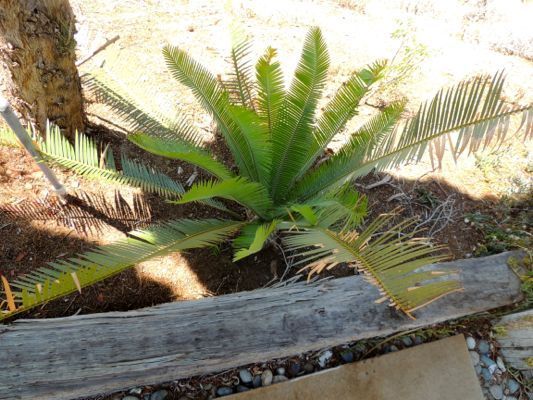
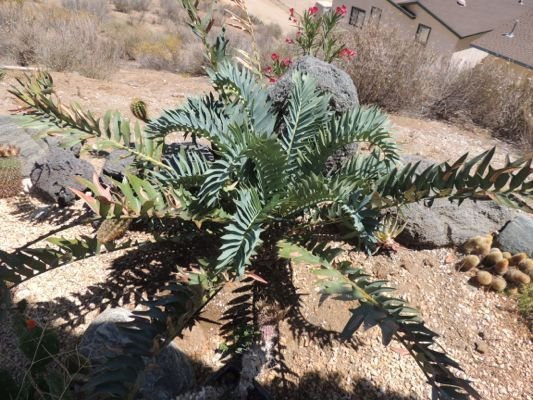
Both these cycads made new leaves here. Both are fairly hardy plants and known for their drought tolerance.... but wind tolerance is another thing. Note the new flushes are barely even half the length of the previous leaves... these are becoming 'bonsais' of their former selves.
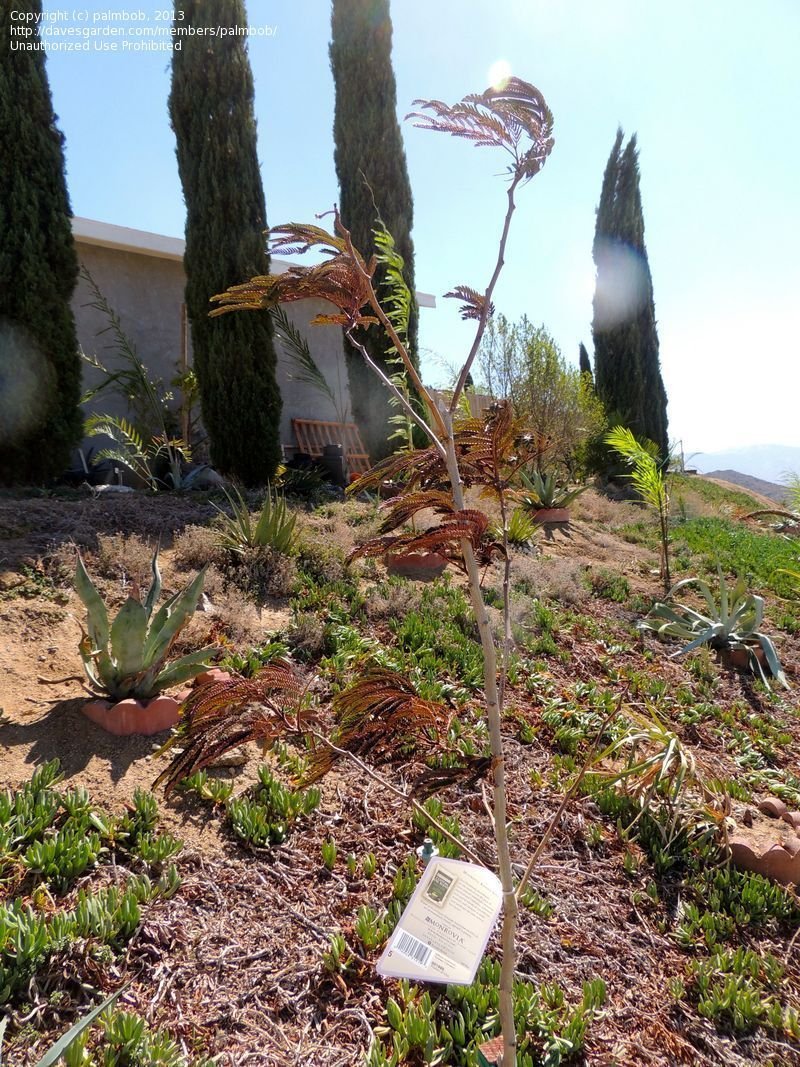
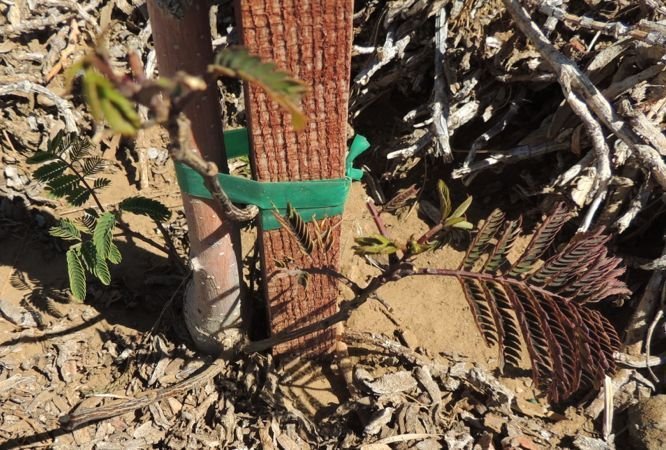
Albizia 'Chocolate' when planted... and a year later of living in a wind tunnel
Cold winds in the middle of winter have an additional negative influence: a wind chill effect that is incredibly damaging. Not only is it desiccating, but it can physically scorch the foliage and sometimes the larger plant structures as well (branches and even trunks). Wind chill is a cooling of the 'resting air' basically exposing the plants to more cooling/freezing than they would experience were there no wind. So the winds can be a bit cooling on a hot day, and even warming on a cold, otherwise still day with a frost... but once real cold exists, they usually tend to make things worse.
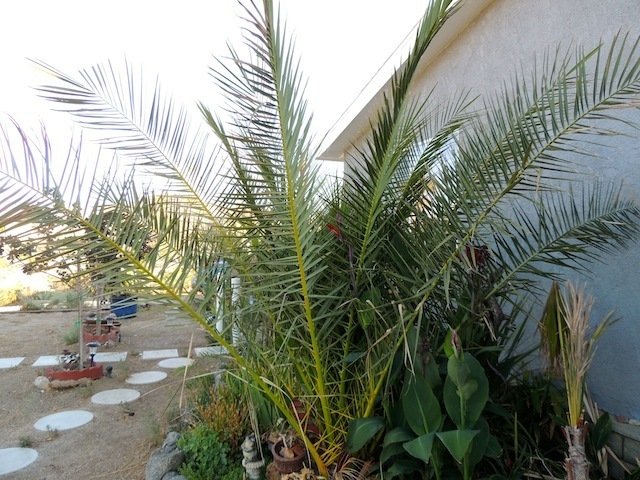
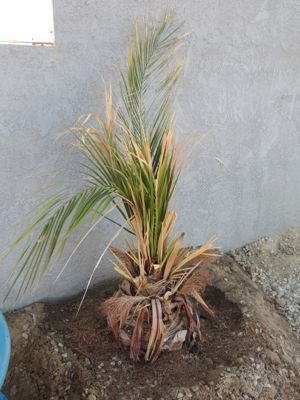
Bought several Phoenix palms... left is one planted against house- gets minimal winds; right is one planted where wind epxosure exists... barely still alive
Winds change the shape of plants (most get shorter, some lean and many just looks scraggly and sparse all the time). Many of the plants I have in the yard have a distinctive lean to them, indicating the direction the wind blows most often. My location is rather unique and the multidirection winds have kept many plants from leaning in just one direction, and the constant leaning back and forth has seriously weakened some of their roots and they end up blowing over, one direction or another. I have learned to post of most trees with posts on either side... but forget the wind comes from at least 4 directions here (thankfully, 90% of the time, its from two basic directions).
The wind also dries out the soil, which is incredibly dry already, and extremely porous (when one says 'well draining soil, one should be comparing that to Acton soil, which drains about as well as gravel does). So watering needs to be done nearly daily, even for drought tolerant plants (the word drought tolerant has a new meaning in this situation- even some of the most drought tolerant plants I know of require nearly daily watering, at least for the first few years, in this climate and wind exposure). It is no wonder this property was basically barren when we moved in. It was not just due to lack of canopy and water. It was due to the wind in a big part. And my efforts to make it less barren have been met with extremely variable success.
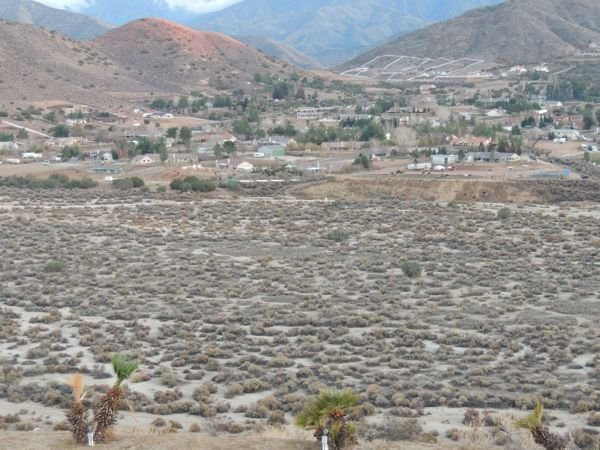
surrounding vegetation before moving in (aside from neighbor's palms... which are also dying)... everything is dead
Another effect of constant wind, particularly in the desert, is the constant blowing of dust and sand. Not only do these particles damage foliage but they also can 'clog' the stomas making them unable to close, resulting in massive desiccation and leaf death.
So what is to be done about the wind? Wind breaks are one of my best hopes. I am currently growing Oleander and Eucalyptus on the hillsides to make a large living wind screen. Both are fairly drought and wind tolerant plants and I have seen many visual barriers in this town made with these plants... but none on hilltops. My efforts to grow Oleander have been successful in that it is still alive and it is growing... but not at the rate I imagine it grows in most other climates in which it can survive. At this rate, it will take a good dozen years to create my living wind break. The Eucalyptus is working out a bit better, but it's not as effective a wind break (unless planted as a solid wall of tree). I am also trying with many other desert trees that are supposed to make good light canopy for smaller plants, though these are all poor windbreaks. However getting any of these trees and shrubs up to size is so far turning out to be frustrating. Its a complex problem involving a chicken and egg scenario. Need a windscreen and canopy to grows these plants that I am growing to make wind screens and canopies...
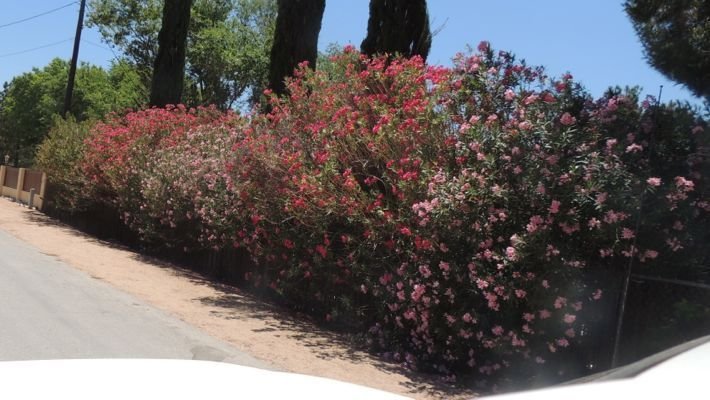
Oleander wind break on property nearby... maybe in a few dozen years??
Obviously staking up all trees is rather important (actually essential it turns out). Though particularly beefy winds just snap off these posts at ground level. In one case I have had to concrete in two 4x4 posts on either side of a tree and rope it up into place (in other words, upright... it worked... but not the most ornamental situation... and I don't really want hundreds of 4x4 posts concreted into the landscape all over the place). I have learned to plant things as close to the house as possible (NOT the look we had hoped for, actually)... the more cold sensitve stuff on the south side of the house (as long as they can tolerate a summer long of furnace-like blasts), and the most cold tolerant stuff on the north side, including the stuff that cannot tolerate the southern furnace winds. It is a slow learning process and incredibly frustrating. But at least fodder for an article!
Probably the best option (though highly costly, likely unsightful and probably not even legal) would be to surround the property with a high brick, rock or concrete wall. THEN I could protect the plants enough to allow them the luxury to become adapted to the weather (cold, hot, humidity etc.) without the complication of wind. Not realistic, sadly. Wife nixed it based on lack of view (as well as ridiculous costliness), which was a big selling point of this property in the first place (don't want to look at high walls in every direction). Planting only plants that can survive massive constant winds has occurred to me... but what fun is that? Besides, in most cases, that would be the same as doing nothing and leaving this a barren hillside save a few native yuccas and creosote bushes... not really the look I was hoping for. Moving has occurred to me, too, but the wife, who has been blessed with the ability to care less about the garden as long as it doesn't affect her directly, is totally against it...we do have great views from up here... when you can stand still enough to enjoy them.
Copyright © www.100flowers.win Botanic Garden All Rights Reserved